Modeling the Consumers Opinion Influence in Online Social Media in the Case of Eco-friendly Products
Abstract
1. Introduction
2. Literature Review
3. Agent-Based Modeling
3.1. Examples of Agent-Based Modeling Applications
3.2. The Properties of the Agents
- Autonomy—the agents’ property of performing most of their tasks without human direct intervention;
- Social ability—the agents interact with other agents and humans;
- Responsiveness—the agents perceive the environment and act accordingly;
- Proactiveness—the agents should be able to exhibit goal-directed behavior and, if needed, they should take action;
- Adaptability—the agents are able to modify their behavior in response to the changes in environment;
- Mobility—the agents are able to explore the environment;
- Veracity—once created, the agents cannot communicate false information;
- Rationality—the agents act for achieving their goals.
4. Consumer Influence
4.1. Gathering the Data Throught a Questionnaire
- Durable goods: electronics, intelligent lighting systems, intelligent heating systems, electric cars, green houses, etc.;
- Soft goods: natural cosmetics, natural laundry, compostable cutlery, eyewear made from natural materials, natural cleaning products, watches made out of sustainable materials, dish towels, reusable coffee filters, reusable tea bag, rechargeable batteries, fabrics colored with vegetable dye or with natural paintings, products made out of recycled material, etc.
- Uni-dimensionality—is tested through the values recorded for the standardized regression weights. In order to validate the construct uni-dimensionality, all the values for these factor loading should be at least 0.5. A value closer to 0.7 or greater is preferred. Table 1 presents the values for the standardized regression weights. It can easily be observed that all the values are greater than 0.5, most of them being greater than 0.7. Thus, the uni-dimensionality is fulfilled.
- Feasibility and convergent validity—is tested through the values determined for average variance extracted (AVE) and construct reliability (CR). As IBM SPSS Amos 22.0.0 does not provide the values for these indicators, we have determined them manually based on the formulas provided by Spanos and Lioukas [90]. Usually, a CR greater than 0.7 suggests a good feasibility (in some cases, even a value between 0.6 and 0.7 is considered acceptable) [91]. In our case, all the values recorded for CR are above 0.877 (see Table 1), indicating a good feasibility. As for the AVE, a value of 0.5 or greater indicates a good convergent validity. If the value is significantly under the threshold of 0.5, then the error in each factor is greater than the variance explained by that factor and the model does not present a good convergent validity. In our case (Table 1) the smallest value recorded for AVE is 0.529, which is above the imposed threshold of 0.5, demonstrating a good convergent validity.
- Similarity validity—is performed through the goodness of fit (GOF). In order to validate the similarity, first, the residuals covariances matrix is considered—all the values within this matrix should be under the value of 4.0. In our case, the highest value in this matrix is 3.524, which is below the threshold of 4.0, indicating a good validity. Second, the indicators listed by IBM SPSS AMOS 22.0.0 under the “Model fit summary” output section are investigated in order to confirm that the similarity validity is passed. Table 2 presents the values calculated for the minimum discrepancy over the degrees of freedom (CMIN/DF). This value should be smaller than 5.0, a smaller value being preferred. In our case (Table 2) the CMIN/DF is equal to 2.220 < 5.0, which makes us believe that the model similarity is validated.
4.2. Analyzing the Data
5. Consumers’ Influence Model in NetLogo
5.1. Model’s Parameters
- Case 1: Soft goods—only interactions between agents;
- Case 2: Soft goods—both interactions between agents and online media exposure;
- Case 3: Durable goods—only interactions between agents;
- Case 4: Durable goods—both interactions between agents and online media exposure.
- For soft eco-friendly products:
- For durable eco-friendly products
5.2. Simulation and Results
5.2.1. Sensitivity Analysis Related to the Number of Agents
5.2.2. Sensitivity Analysis Related to the Average Media Exposure
6. Conclusions
Author Contributions
Funding
Acknowledgments
Conflicts of Interest
Appendix A. Research Questionnaire
| Issue | Acronym | Questions | Strongly Disagree | Disagree | Neutral | Agree | Strongly Agree |
|---|---|---|---|---|---|---|---|
| Knowledge Degree | KD | I know how to recognize an eco-friendly product | □ | □ | □ | □ | □ |
| I know that even the durable goods can be eco-friendly and I know how to recognize them | □ | □ | □ | □ | □ | ||
| I know to give an example of reusable-alternatives to non-eco-friendly products | □ | □ | □ | □ | □ | ||
| I understand that using an eco-friendly product reduce the damage caused to the environment | □ | □ | □ | □ | □ | ||
| Environmental Awareness | E-AW | I think that the human actions are affecting the environment | □ | □ | □ | □ | □ |
| I think that each human is responsible of what happens to our planet | □ | □ | □ | □ | □ | ||
| I think that if no action is taken with respect to protecting the environment, the situation would be getting worse | □ | □ | □ | □ | □ | ||
| Environmental Attitude | E-AT | I think that it is important to take action and limit the damages caused to the environment | □ | □ | □ | □ | □ |
| An environmentally-friendly attitude towards environment is needed | □ | □ | □ | □ | □ | ||
| It is very important to promote consumers’ attention to environmental issues through online social media platforms | □ | □ | □ | □ | □ | ||
| Online Media Exposure | OME | I often see messages of eco-friendly products on online social media | □ | □ | □ | □ | □ |
| I often read posts written by my friends in online social networks related to eco-friendly products | □ | □ | □ | □ | □ | ||
| Online Social Influence—Power to Influence | OSI-PI | I often share information related to eco-friendly products on online social media | □ | □ | □ | □ | □ |
| I discuss with my friends from online social networks about the need to adopt eco-friendly products | □ | □ | □ | □ | □ | ||
| I think that I can change my fiends’ attitudes and thus, I engage myself in public topics on online social media related to environment protection and eco-friendly products | □ | □ | □ | □ | □ | ||
| Online Social Influence—Susceptibility to be Influenced | OSI-SI | I am interested in discussing with the persons in online social media about the benefits of the eco-friendly products and upon these discussions, I decide whether to buy the products or not | □ | □ | □ | □ | □ |
| If my friends in online social media promote some eco-friendly products, it is very likely to start buying them | □ | □ | □ | □ | □ | ||
| If I see many advertisements about some eco-friendly products in social media, I start reading about them and it is very likely to start buying or to recommend them to my fiends | □ | □ | □ | □ | □ | ||
| Buying Intention and Decision | BID | In the future, I think I will read more about the new eco-friendly products and, if I will be content about their advantages, I will buy them | □ | □ | □ | □ | □ |
| I will buy eco-friendly products even though they will be more expensive than the normal products | □ | □ | □ | □ | □ | ||
| I will buy eco-friendly products even though, in some cases, they will be less appealing than the non-eco-friendly products | □ | □ | □ | □ | □ | ||
| I will start to buy and replace the non-eco-friendly products with their reusable-alternatives | □ | □ | □ | □ | □ | ||
| I plan to buy as many eco-friendly products as possible | □ | □ | □ | □ | □ |
Appendix B. Simulation Examples
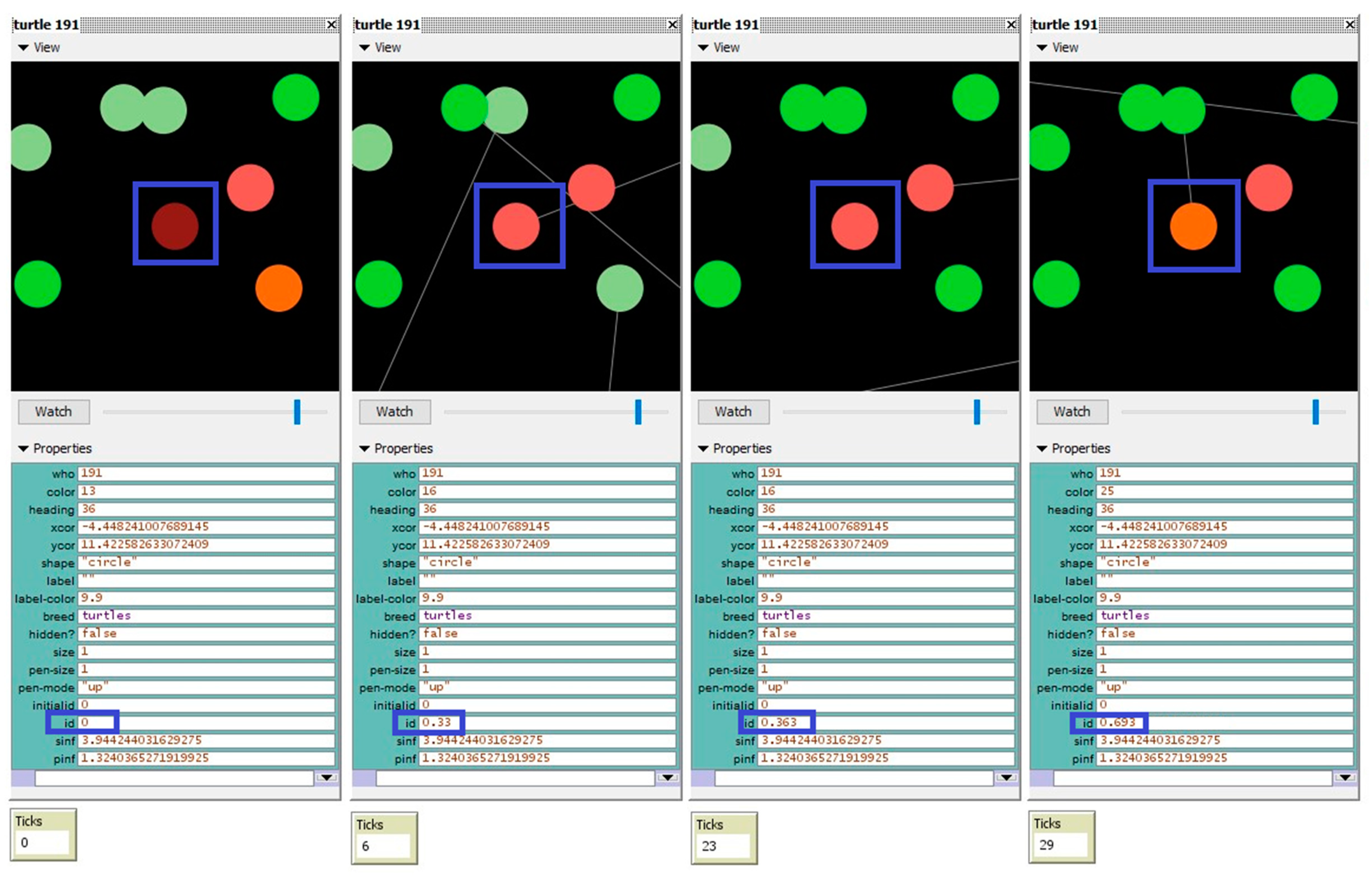

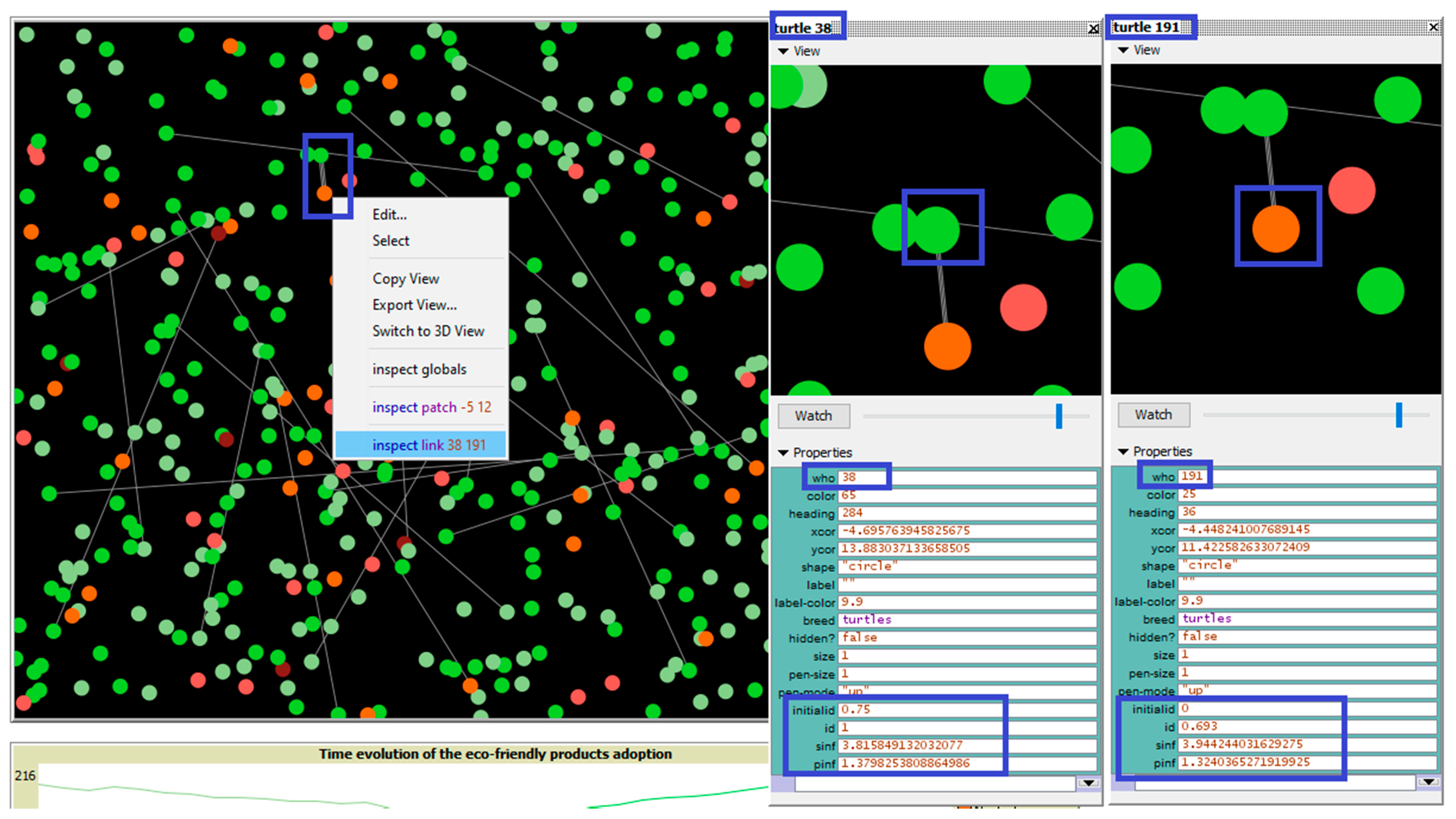
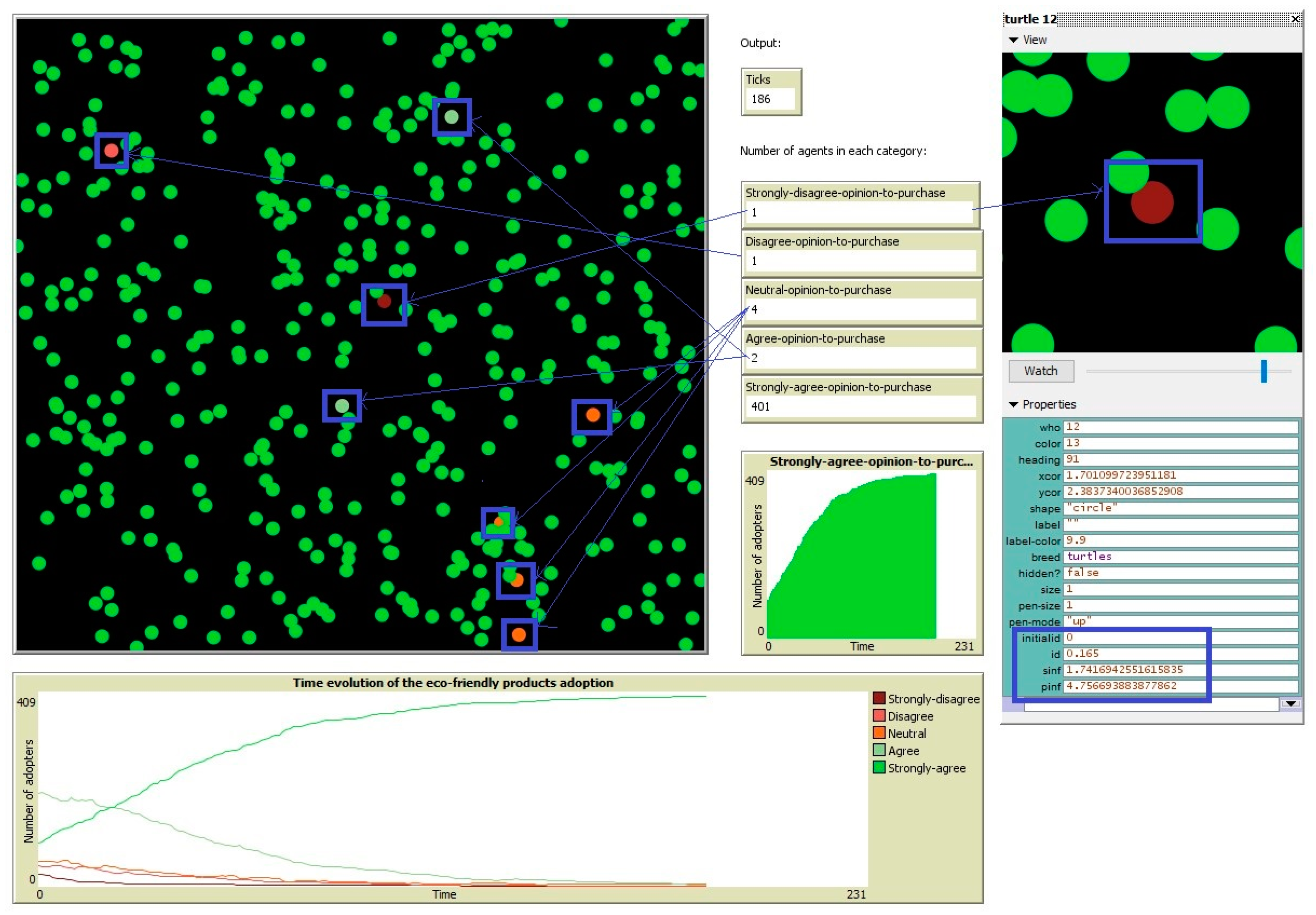
References
- El-Mously, H. Innovating green products as a mean to alleviate poverty in Upper Egypt. Ain Shams Eng. J. 2018, 9, 2039–2056. [Google Scholar] [CrossRef]
- De Medeiros, J.F.; Ribeiro, J.L.D. Environmentally sustainable innovation: Expected attributes in the purchase of green products. J. Clean. Prod. 2017, 142, 240–248. [Google Scholar] [CrossRef]
- Zhang, W.; He, Y. Optimal policies for new and green remanufactured short-life-cycle products considering consumer behavior. J. Clean. Prod. 2019, 214, 483–505. [Google Scholar] [CrossRef]
- Wang, Z.; Zhang, B.; Yin, J.; Zhang, X. Willingness and behavior towards e-waste recycling for residents in Beijing city, China. J. Clean. Prod. 2011, 19, 977–984. [Google Scholar] [CrossRef]
- Miafodzyeva, S.; Brandt, N. Recycling Behaviour Among Householders: Synthesizing Determinants Via a Meta-analysis. Waste Biomass Valoriz. 2013, 4, 221–235. [Google Scholar] [CrossRef]
- Dias, P.; Bernardes, A.M.; Huda, N. Ensuring best E-waste recycling practices in developed countries: An Australian example. J. Clean. Prod. 2019, 209, 846–854. [Google Scholar] [CrossRef]
- Chen, C.-C.; Chen, C.-W.; Tung, Y.-C. Exploring the Consumer Behavior of Intention to Purchase Green Products in Belt and Road Countries: An Empirical Analysis. Sustainability 2018, 10, 854. [Google Scholar] [CrossRef]
- Doha, A.; Elnahla, N.; McShane, L. Social commerce as social networking. J. Retail. Consum. Serv. 2019, 47, 307–321. [Google Scholar] [CrossRef]
- Asim, Y.; Malik, A.K.; Raza, B.; Shahid, A.R. A trust model for analysis of trust, influence and their relationship in social network communities. Telemat. Inform. 2019, 36, 94–116. [Google Scholar] [CrossRef]
- Kujur, F.; Singh, S. Engaging customers through online participation in social networking sites. Asia Pac. Manag. Rev. 2017, 22, 16–24. [Google Scholar] [CrossRef]
- Lim, H.; Kumar, A. Variations in consumers’ use of brand online social networking: A uses and gratifications approach. J. Retail. Consum. Serv. 2017. [Google Scholar] [CrossRef]
- Wang, F.; Jiang, W.; Li, X.; Wang, G. Maximizing positive influence spread in online social networks via fluid dynamics. Fut. Gener. Comput. Syst. 2018, 86, 1491–1502. [Google Scholar] [CrossRef]
- Delcea, C.; Popa, C.D.S.; Boloş, M. Consumers’ Decisions in Grey Online Social Networks. J. Grey Syst. 2015, 27. [Google Scholar]
- Delcea, C.; Scarlat, E. Grey relational analysis between social media engagement and users’ decisions. In Proceedings of the IEEE International Conference Grey Systems and Intelligent Services (GSIS), Leicester, UK, 18–20 August 2015; pp. 134–138. [Google Scholar]
- Fami, H.S.; Aramyan, L.H.; Sijtsema, S.J.; Alambaigi, A. Determinants of household food waste behavior in Tehran city: A structural model. Resour. Conserv. Recycl. 2019, 143, 154–166. [Google Scholar] [CrossRef]
- Mattar, L.; Abiad, M.G.; Chalak, A.; Diab, M.; Hassan, H. Attitudes and behaviors shaping household food waste generation: Lessons from Lebanon. J. Clean. Prod. 2018, 198, 1219–1223. [Google Scholar] [CrossRef]
- Nikolaus, C.J.; Nickols-Richardson, S.M.; Ellison, B. Wasted food: A qualitative study of U.S. young adults’ perceptions, beliefs and behaviors. Appetite 2018, 130, 70–78. [Google Scholar] [CrossRef]
- Corrado, S.; Caldeira, C.; Eriksson, M.; Hanssen, O.J.; Hauser, H.-E.; van Holsteijn, F.; Liu, G.; Östergren, K.; Parry, A.; Secondi, L.; et al. Food waste accounting methodologies: Challenges, opportunities, and further advancements. Glob. Food Secur. 2019, 20, 93–100. [Google Scholar] [CrossRef]
- Schmidt, K.; Matthies, E. Where to start fighting the food waste problem? Identifying most promising entry points for intervention programs to reduce household food waste and overconsumption of food. Resour. Conserv. Recycl. 2018, 139, 1–14. [Google Scholar] [CrossRef]
- Buchner, B.; Fischler, C.; Gustafson, E.; Reilly, J.; Riccardi, G.; Ricordi, C.; Veronesi, U. Food Waste: Causes, Impacts and Proposals; Codice Edizioni: Torino, Italy, 2012. [Google Scholar]
- Lucifero, N. Food Loss and Waste in the EU Law between Sustainability of Well-being and the Implications on Food System and on Environment. Agric. Sci. Proced. 2016, 8, 282–289. [Google Scholar] [CrossRef][Green Version]
- Stenmarck, Å.; Jensen, C.; Quested, T.; Moates, G.; Buksti, M.; Cseh, B.; Juul, S.; Parry, A.; Politano, A.; Redlingshofer, B.; et al. Estimates of European Food Waste Levels. Available online: http://edepot.wur.nl/378674 (accessed on 25 February 2019).
- Scherhaufer, S.; Moates, G.; Hartikainen, H.; Waldron, K.; Obersteiner, G. Environmental impacts of food waste in Europe. Waste Manag. 2018, 77, 98–113. [Google Scholar] [CrossRef] [PubMed]
- Revilla, B.P.; Salet, W. The social meaning and function of household food rituals in preventing food waste. J. Clean. Prod. 2018, 198, 320–332. [Google Scholar] [CrossRef]
- Schanes, K.; Dobernig, K.; Gözet, B. Food waste matters—A systematic review of household food waste practices and their policy implications. J. Clean. Prod. 2018, 182, 978–991. [Google Scholar] [CrossRef]
- Hole, G.; Hole, A.S. Recycling as the way to greener production: A mini review. J. Clean. Prod. 2019, 212, 910–915. [Google Scholar] [CrossRef]
- Qi, Y.; Xiao, X.; Lu, Y.; Shu, J.; Wang, J.; Chen, M. Cathode ray tubes glass recycling: A review. Sci. Total Environ. 2019, 650, 2842–2849. [Google Scholar] [CrossRef]
- Mercante, I.; Alejandrino, C.; Ojeda, J.P.; Chini, J.; Maroto, C.; Fajardo, N. Mortar and concrete composites with recycled plastic: A review. Sci. Technol. Mater. 2018, 30, 69–79. [Google Scholar] [CrossRef]
- Horckmans, L.; Nielsen, P.; Dierckx, P.; Ducastel, A. Recycling of refractory bricks used in basic steelmaking: A review. Resour. Conserv. Recycl. 2019, 140, 297–304. [Google Scholar] [CrossRef]
- Sandin, G.; Peters, G.M. Environmental impact of textile reuse and recycling—A review. J. Clean. Prod. 2018, 184, 353–365. [Google Scholar] [CrossRef]
- Maniatis, P. Investigating factors influencing consumer decision-making while choosing green products. J. Clean. Prod. 2016, 132, 215–228. [Google Scholar] [CrossRef]
- Wei, S.; Ang, T.; Jancenelle, V.E. Willingness to pay more for green products: The interplay of consumer characteristics and customer participation. J. Retail. Consum. Serv. 2018, 45, 230–238. [Google Scholar] [CrossRef]
- Sanjuán, A.I.; Sánchez, M.; Gil, J.M.; Gracia, A.; Soler, F. Brakes to organic market enlargement in Spain: Consumers’ and retailers’ attitudes and willingness to pay. Int. J. Consum. Stud. 2003, 27, 134–144. [Google Scholar] [CrossRef]
- Sakagami, M.; Sato, M.; Ueta, K. Measuring consumer preferences regarding organic labelling and the JAS label in particular. N. Z. J. Agric. Res. 2006, 49, 247–254. [Google Scholar] [CrossRef]
- International Marketing and Trade of Quality Food Product; Canavari, M., Cantore, N., Castellini, A., Pignatti, E., Spadoni, R., Eds.; Wageningen Academic Publishers: Wageningen, The Netherlands, 2009. [Google Scholar]
- Thøgersen, J.; Jørgensen, A.-K.; Sandager, S. Consumer Decision Making Regarding a “Green” Everyday Product. Psychol. Mark. 2012, 29, 187–197. [Google Scholar] [CrossRef]
- Sinnappan, P.; Rahman, A.A. Antecedents of Green Purchasing Behavior among Malaysian Consumers. Int. Bus. Manag. 2011, 5, 129–139. [Google Scholar] [CrossRef]
- Vikan, A.; Camino, C.; Biaggio, A.; Nordvik, H. Endorsement of the New Ecological Paradigm. Environ. Behav. 2007, 39, 217–228. [Google Scholar] [CrossRef]
- Khan, S.N.; Mohsin, M. The power of emotional value: Exploring the effects of values on green product consumer choice behavior. J. Clean. Prod. 2017, 150, 65–74. [Google Scholar] [CrossRef]
- Sheth, J.N.; Newman, B.I.; Gross, B.L. Why we buy what we buy: A theory of consumption values. J. Bus. Res. 1991, 22, 159–170. [Google Scholar] [CrossRef]
- Sweeney, J.C.; Soutar, G.N. Consumer perceived value: The development of a multiple item scale. J. Retail. 2001, 77, 203–220. [Google Scholar] [CrossRef]
- Hussain, M.A.; Khokhar, M.F.; Asad, A. Green Awareness Effects on Consumers Purchasing Decision: A Case of Pakistan. Glob. J. Manag. Bus. Res. 2014, 14, 8–16. [Google Scholar]
- Akbar, W.; Hassan, S.; Khurshid, S.; Niaz, M.; Rizwan, M. Antecedents Affecting Customer’s Purchase Intentions towards Green Products. J. Sociol. Res. 2014, 5. [Google Scholar] [CrossRef][Green Version]
- Wilensky, U.; Rand, W. An Introduction to Agent-Based Modeling: Modeling Natural, Social, and Engineered Complex Systems with NetLogo; The MIT Press: Cambridge, MA, USA, 2015. [Google Scholar]
- Delcea, C.; Bradea, I.A. Economic Cybernetics. An Equation-Based Modeling and Agent-Based Modeling Approach; Editura Universitara: Bucharest, Romania, 2017. [Google Scholar]
- Dyke, H.V. Practical and Industrial Applications of Agent-Based Systems. 1998. Available online: https://pdfs.semanticscholar.org/19b7/11ec0ef8ea4658d557e9354e432eb6e44506.pdf?_ga=2.178723300.1998167298.1553419165-1067836565.1489167981 (accessed on 25 February 2019).
- Stonedahl, F.; Wilensky, U. Finding Forms of Flocking: Evolutionary Search in ABM Parameter-Spaces. In Multi-Agent-Based Simulation XI; Bosse, T., Geller, A., Jonker, C.M., Eds.; Springer: Berlin/Heidelberg, Germany, 2011; Volume 6532, pp. 61–75. [Google Scholar]
- Wilkerson-Jerde, M.; Wilensky, U. Seeing Change in the World from Different Levels: Understanding the Mathematics of Complex Systems. In Proceedings of the 9th International Conference of the Learning Sciences, Chicago, IL, USA, 29 June–2 July 2010; International Society of the Learning Sciences: Chicago, IL, USA, 2010; Volume 2, pp. 190–192. [Google Scholar]
- Chen, L. Agent-based modeling in urban and architectural research: A brief literature review. Front. Archit. Res. 2012, 1, 166–177. [Google Scholar] [CrossRef]
- Railsback, S.F.; Lytinen, S.L.; Jackson, S.K. Agent-based Simulation Platforms: Review and Development Recommendations. Simulation 2006, 82, 609–623. [Google Scholar] [CrossRef]
- Badham, J. Review of An Introduction to Agent-Based Modeling: Modeling Natural, Social, and Engineered Complex Systems with NETLogo. Available online: http://jasss.soc.surrey.ac.uk/18/4/reviews/2.html (accessed on 31 July 2016).
- Klopfer, E.; Scheintaub, H.; Huang, W.; Wendel, D. StarLogo TNG. In Artificial Life Models in Software; Komosinski, M., Adamatzky, A., Eds.; Springer: London, UK, 2009; pp. 151–182. [Google Scholar]
- West, T.A.P.; Grogan, K.A.; Swisher, M.E.; Caviglia-Harris, J.L.; Sills, E.; Harris, D.; Roberts, D.; Putz, F.E. A hybrid optimization-agent-based model of REDD+ payments to households on an old deforestation frontier in the Brazilian Amazon. Environ. Model. Softw. 2018, 100, 159–174. [Google Scholar] [CrossRef]
- Banitz, T.; Gras, A.; Ginovart, M. Individual-based modeling of soil organic matter in NetLogo: Transparent, user-friendly, and open. Environ. Model. Softw. 2015, 71, 39–45. [Google Scholar] [CrossRef]
- Speelman, E.N.; García-Barrios, L.E. Agrodiversity v.2: An educational simulation tool to address some challenges for sustaining functional agrodiversity in agro-ecosystems. Ecol. Model. 2010, 221, 911–918. [Google Scholar] [CrossRef]
- DeGregorio, B.A.; Westervelt, J.D.; Weatherhead, P.J.; Sperry, J.H. Indirect effect of climate change: Shifts in ratsnake behavior alter intensity and timing of avian nest predation. Ecol. Model. 2015, 312, 239–246. [Google Scholar] [CrossRef]
- Castilla-Rho, J.C.; Mariethoz, G.; Rojas, R.; Andersen, M.S.; Kelly, B.F.J. An agent-based platform for simulating complex human–aquifer interactions in managed groundwater systems. Environ. Model. Softw. 2015, 73, 305–323. [Google Scholar] [CrossRef]
- Liu, Y. Relationship between industrial firms, high-carbon and low-carbon energy: An agent-based simulation approach. Appl. Math. Comput. 2013, 219, 7472–7479. [Google Scholar] [CrossRef]
- Tarigan, S.D. Modeling effectiveness of management practices for flood mitigation using GIS spatial analysis functions in Upper Cilliwung watershed. IOP Conf. Ser. Earth Environ. Sci. 2016, 31, 012030. [Google Scholar] [CrossRef]
- Karsai, I.; Roland, B.; Kampis, G. The effect of fire on an abstract forest ecosystem: An agent based study. Ecol. Complex. 2016, 28, 12–23. [Google Scholar] [CrossRef]
- Miller, B.W.; Breckheimer, I.; McCleary, A.L.; Guzmán-Ramirez, L.; Caplow, S.C.; Jones-Smith, J.C.; Walsh, S.J. Using stylized agent-based models for population–environment research: A case study from the Galápagos Islands. Popul. Environ. 2010, 31, 401–426. [Google Scholar] [CrossRef]
- Gao, M.; Zhou, L.; Chen, Y. An Alternative Approach for High Speed Railway Carrying Capacity Calculation Based on Multiagent Simulation. Discret. Dyn. Nat. Soc. 2016, 2016, e4278073. [Google Scholar] [CrossRef]
- Riaz, F.; Jabbar, S.; Sajid, M.; Ahmad, M.; Naseer, K.; Ali, N. A collision avoidance scheme for autonomous vehicles inspired by human social norms. Compute. Electr. Eng. 2018, 69, 690–704. [Google Scholar] [CrossRef]
- Vo, T.T.A.; van der Waerden, P.; Wets, G. Micro-simulation of Car Drivers’ Movements at Parking Lots. Proced. Eng. 2016, 142, 100–107. [Google Scholar] [CrossRef]
- Delcea, C.; Cotfas, L.-A.; Salari, M.; Milne, R. Investigating the Random Seat Boarding Method without Seat Assignments with Common Boarding Practices Using an Agent-Based Modeling. Sustainability 2018, 10, 4623. [Google Scholar] [CrossRef]
- Delcea, C.; Cotfas, L.-A.; Paun, R. Airplane Boarding Strategies Using Agent-Based Modeling and Grey Analysis. In Computational Collective Intelligence; Nguyen, N.T., Pimenidis, E., Khan, Z., Trawiński, B., Eds.; Springer International Publishing: Cham, Germany, 2018; Volume 11055, pp. 329–339. [Google Scholar]
- Wang, H.; Mostafizi, A.; Cramer, L.A.; Cox, D.; Park, H. An agent-based model of a multimodal near-field tsunami evacuation: Decision-making and life safety. Trans. Res. Part C Emerg. Technol. 2016, 64, 86–100. [Google Scholar] [CrossRef]
- Gutierrez-Milla, A.; Borges, F.; Suppi, R.; Luque, E. Individual-oriented Model Crowd Evacuations Distributed Simulation. Proced. Comput. Sci. 2014, 29, 1600–1609. [Google Scholar] [CrossRef]
- Nagarajan, M.; Shaw, D.; Albores, P. Informal dissemination scenarios and the effectiveness of evacuation warning dissemination of households—A Simulation study. Proced. Eng. 2010, 3, 139–152. [Google Scholar] [CrossRef]
- Faroqi, H.; Mesgari, M.-S. Agent-Based Crowd Simulation Considering Emotion Contagion for Emergency Evacuation Problem. ISPRS Int. Arch. Photogramm. Remote Sens. Spat. Inform. Sci. 2015, XL-1-W5, 193–196. [Google Scholar] [CrossRef]
- Delcea, C.; Cotfas, L.-A.; Paun, R. Agent-Based Optimization of the Emergency Exits and Desks Placement in Classrooms. In Computational Collective Intelligence; Nguyen, N.T., Pimenidis, E., Khan, Z., Trawiński, B., Eds.; Springer International Publishing: Cham, Germany, 2018; Volume 11055, pp. 340–348. [Google Scholar]
- Liu, R.; Jiang, D.; Shi, L. Agent-based simulation of alternative classroom evacuation scenarios. Front. Arch. Res. 2016, 5, 111–125. [Google Scholar] [CrossRef]
- Taboada, M.; Cabrera, E.; Iglesias, M.L.; Epelde, F.; Luque, E. An Agent-Based Decision Support System for Hospitals Emergency Departments. Proced. Comput. Sci. 2011, 4, 1870–1879. [Google Scholar] [CrossRef]
- Delcea, C.; Bradea, I.A.; Cotfas, L.A.; Scarlat, E. Opinion influence in online social media environments—A grey system theory and agent-based modeling approach. In Proceedings of the 2017 International Conference on Grey Systems and Intelligent Services (GSIS), Stockholm, Sweden, 8–11 August 2017; pp. 349–355. [Google Scholar]
- D’Alessandro, S.; Johnson, L.; Gray, D.; Carter, L. Consumer satisfaction versus churn in the case of upgrades of 3G to 4G cell networks. Mark. Lett. 2015, 26, 489–500. [Google Scholar] [CrossRef]
- Jung, J.J. Measuring trustworthiness of information diffusion by risk discovery process in social networking services. Qual. Quant. 2014, 48, 1325–1336. [Google Scholar] [CrossRef]
- Dubovi, I.; Dagan, E.; Sader Mazbar, O.; Nassar, L.; Levy, S.T. Nursing students learning the pharmacology of diabetes mellitus with complexity-based computerized models: A quasi-experimental study. Nurse Educ. Today 2018, 61, 175–181. [Google Scholar] [CrossRef]
- Shiflet, A.B.; Shiflet, G.W. An Introduction to Agent-based Modeling for Undergraduates. Proced. Comput. Sci. 2014, 29, 1392–1402. [Google Scholar] [CrossRef]
- Dickes, A.C.; Sengupta, P. Learning Natural Selection in 4th Grade with Multi-Agent-Based Computational Models. Res. Sci. Educ. 2013, 43, 921–953. [Google Scholar] [CrossRef]
- Visintainer, T.; Linn, M. Sixth-Grade Students’ Progress in Understanding the Mechanisms of Global Climate Change. J. Sci. Educ. Technol. 2015, 24, 287–310. [Google Scholar] [CrossRef]
- Waight, N.; Gillmeister, K. Teachers and Students’ Conceptions of Computer-Based Models in the Context of High School Chemistry: Elicitations at the Pre-intervention Stage. Res. Sci. Educ. 2014, 44, 335–361. [Google Scholar] [CrossRef]
- Ginovart, M. Discovering the Power of Individual-Based Modelling in Teaching and Learning: The Study of a Predator-Prey System. J. Sci. Educ. Technol. 2014, 23, 496–513. [Google Scholar] [CrossRef]
- Jacobson, M.J.; Kim, B.; Pathak, S.; Zhang, B. To guide or not to guide: Issues in the sequencing of pedagogical structure in computational model-based learning. Interact. Learn. Environ. 2015, 23, 715–730. [Google Scholar] [CrossRef]
- Hmelo-Silver, C.E.; Liu, L.; Gray, S.; Jordan, R. Using representational tools to learn about complex systems: A tale of two classrooms. J. Res. Sci. Teach. 2015, 52, 6–35. [Google Scholar] [CrossRef]
- Shqair, M.; Altarazi, S.; Al-Shihabi, S. A statistical study employing agent-based modeling to estimate the effects of different warehouse parameters on the distance traveled in warehouses. Simul. Model. Pract. Theory 2014, 49, 122–135. [Google Scholar] [CrossRef]
- Kosmann, W.J.; Sarkani, S.; Mazzuchi, T. Optimization of space system development resources. Acta Astronaut. 2013, 87, 48–63. [Google Scholar] [CrossRef]
- Wooldridge, M.; Jennings, N.R. Intelligent agents: Theory and practice. Knowl. Eng. Rev. 1995, 10, 115–152. [Google Scholar] [CrossRef]
- Getchell, A. Agent-based Modeling. Available online: http://rgdoi.net/10.13140/RG.2.1.2880.8803 (accessed on 7 January 2019).
- Koeske, G.F.; Kirk, S.A.; Koeske, R.D.; Rauktis, M.B. Measuring the Monday blues: Validation of a job satisfaction scale for the human services. Soc. Work Res. 1994, 18, 27–35. [Google Scholar] [CrossRef] [PubMed]
- Spanos, Y.E.; Lioukas, S. An examination into the causal logic of rent generation: Contrasting Porter’s competitive strategy framework and the resource-based perspective. Strateg. Manag. J. 2001, 22, 907–934. [Google Scholar] [CrossRef]
- Delcea, C.; Bradea, I.-A. Patients’ perceived risks in hospitals: A grey qualitative analysis. Kybernetes 2017, 46, 1408–1424. [Google Scholar] [CrossRef]
- Brown, T.A. Confirmatory Factor Analysis for Applied Research, 2nd ed.; Methodology in the Social Sciences; The Guilford Press: New York, NY, USA; London, UK, 2015. [Google Scholar]
- Byrne, B.M. Structural Equation Modeling With AMOS: Basic Concepts, Applications, and Programming, 3rd ed.; Routledge: London, UK, 2016. [Google Scholar]
- Hu, L.; Bentler, P.M. Cutoff criteria for fit indexes in covariance structure analysis: Conventional criteria versus new alternatives. Struct. Equ. Model. Multidiscip. J. 1999, 6, 1–55. [Google Scholar] [CrossRef]
- Harrington, D. Confirmatory Factor Analysis; Pocket Guides to Social Work Research Methods; Oxford University Press: Oxford, UK; New York, NY, USA, 2009. [Google Scholar]
- Paswan, A.; D’Souza, D.; Zolfagharian, M.A. Toward a Contextually Anchored Service Innovation Typology. Decis. Sci. 2009, 40, 513–540. [Google Scholar] [CrossRef]


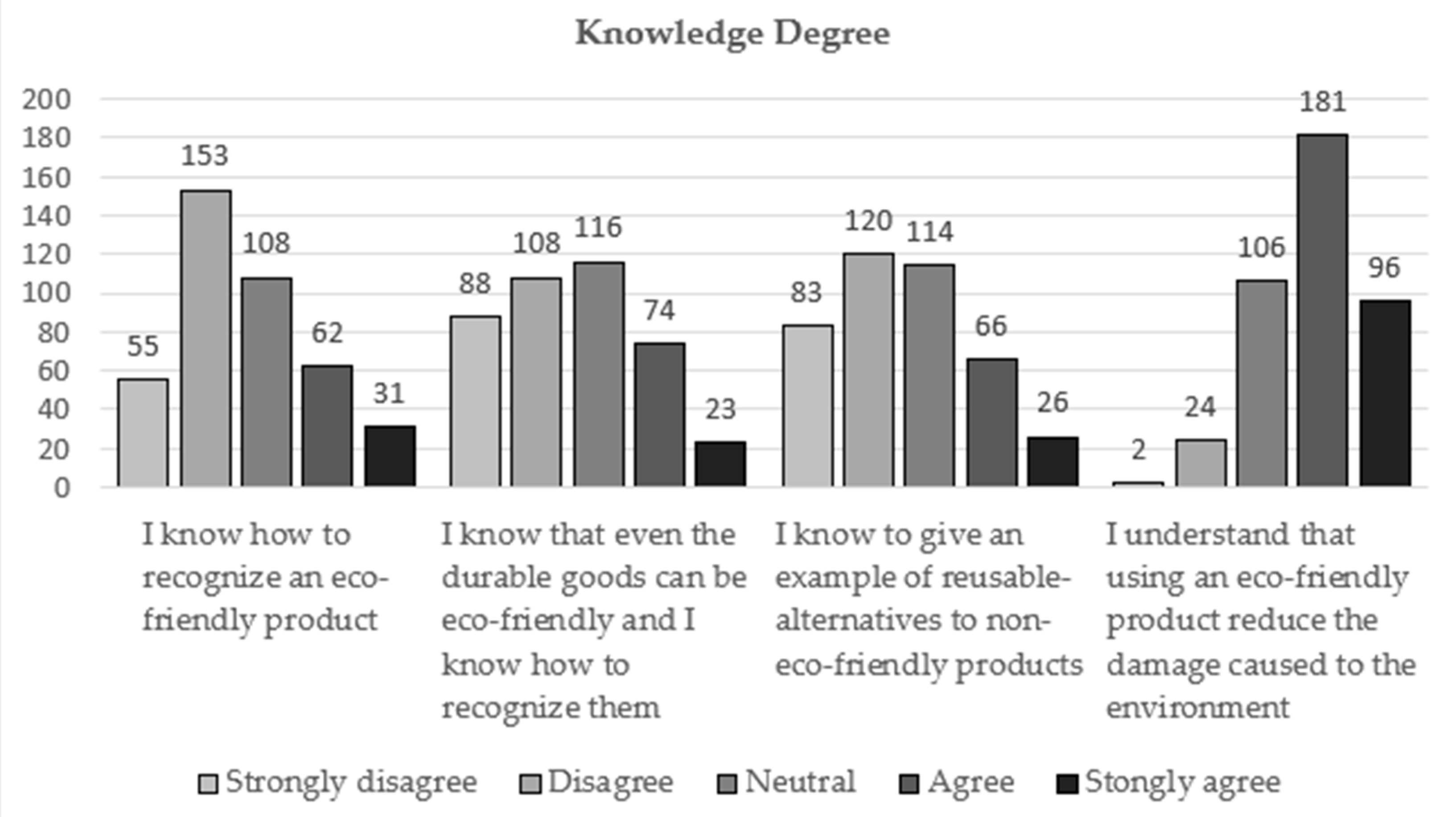


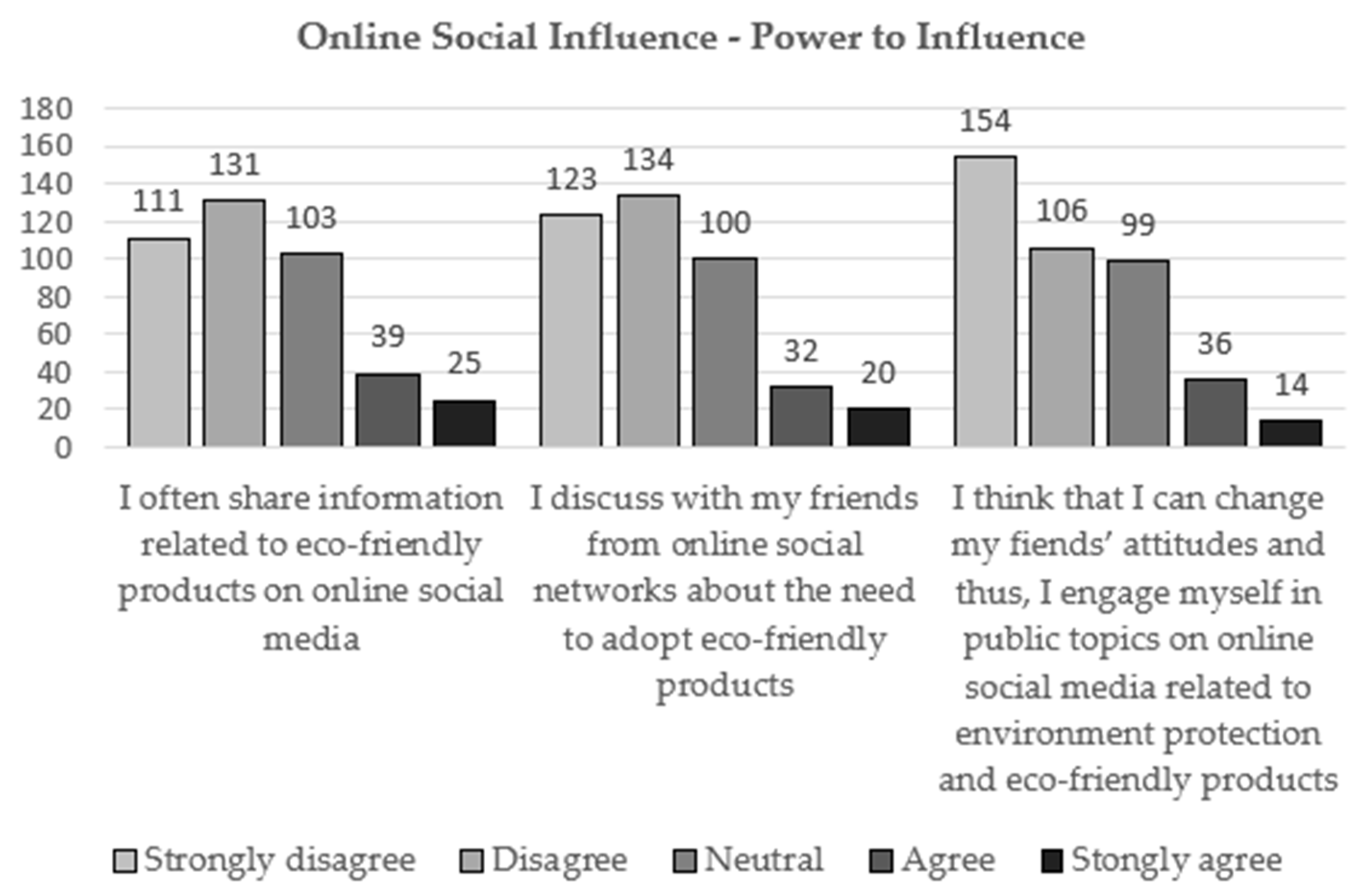
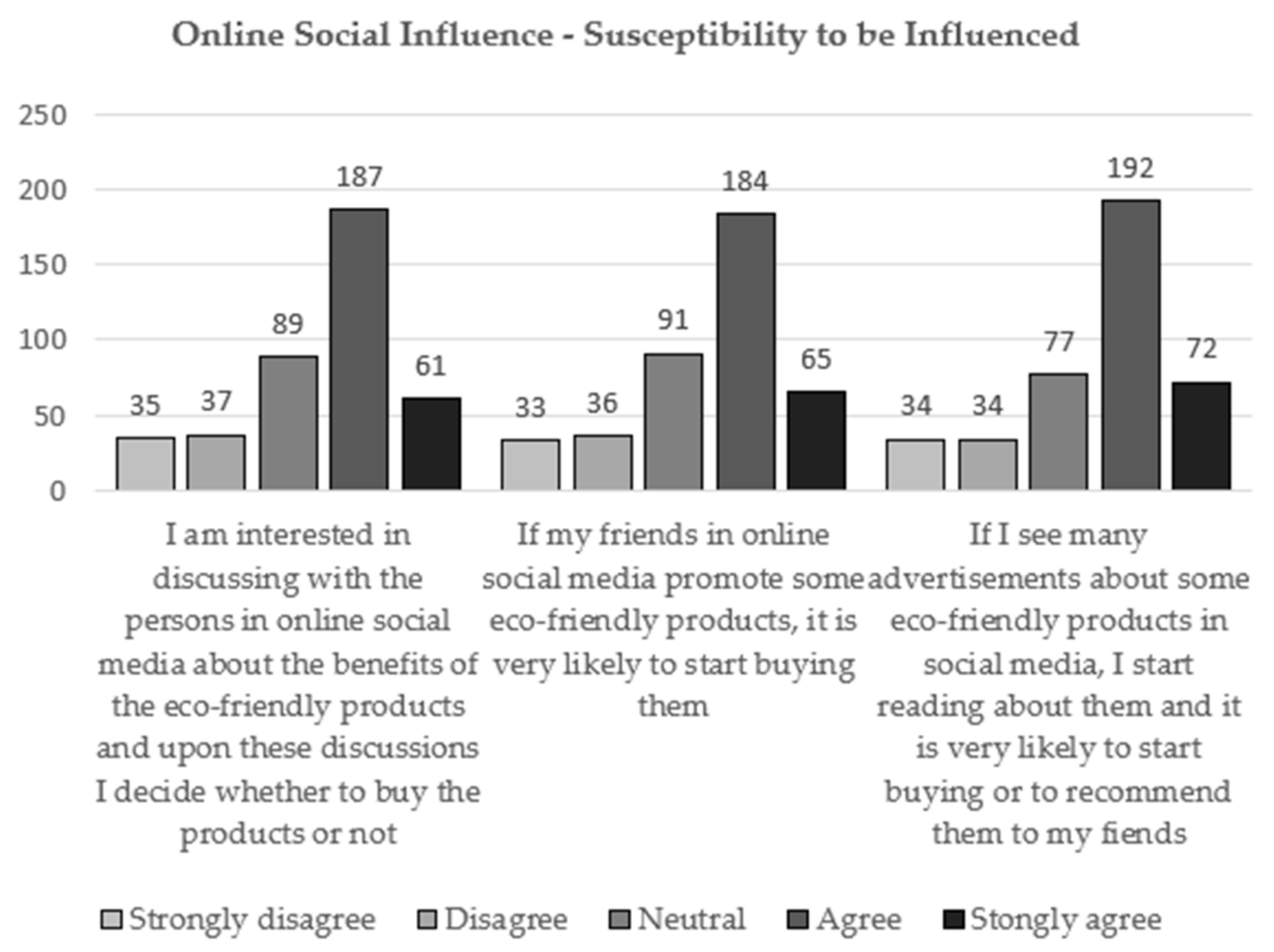
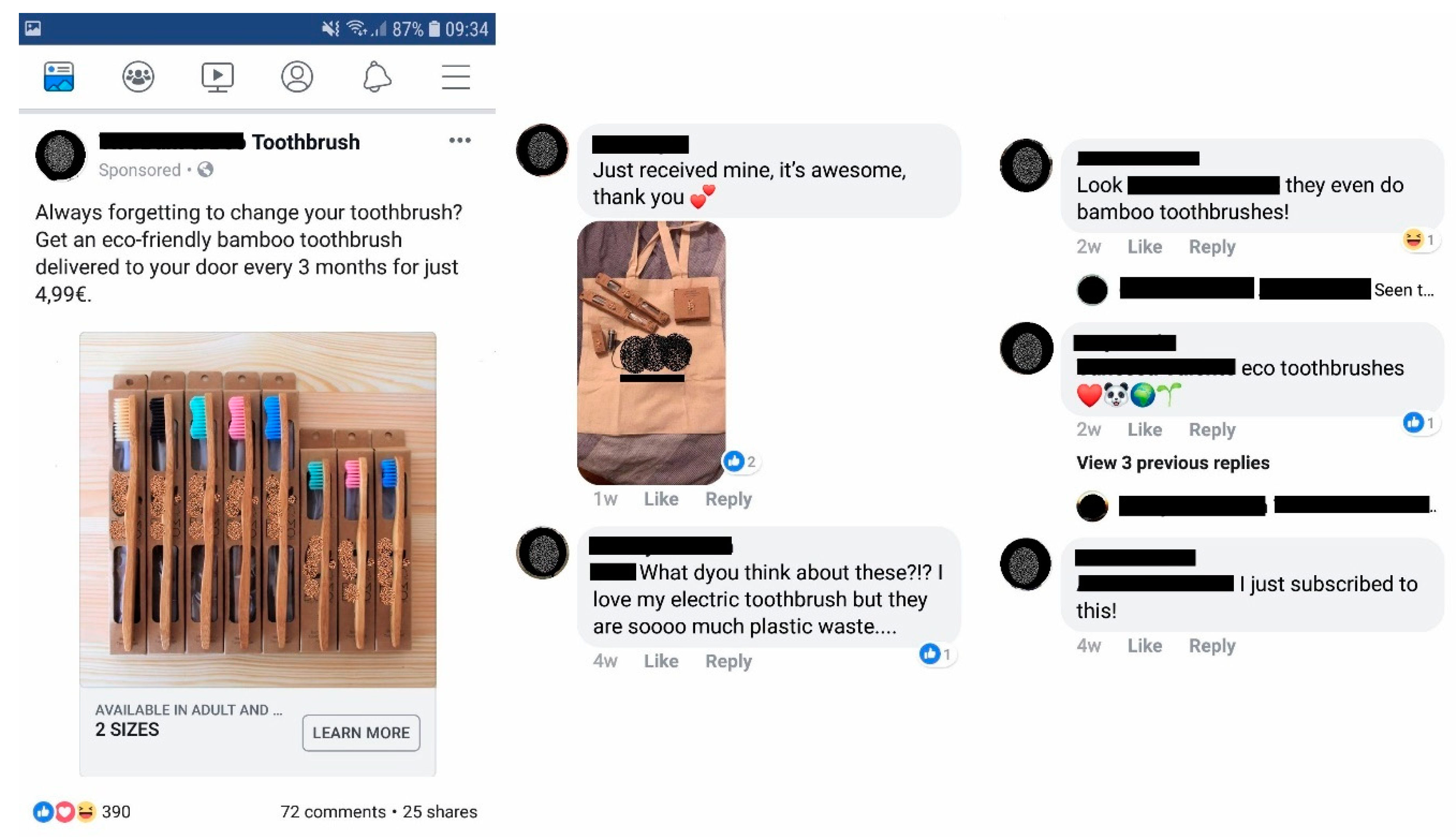
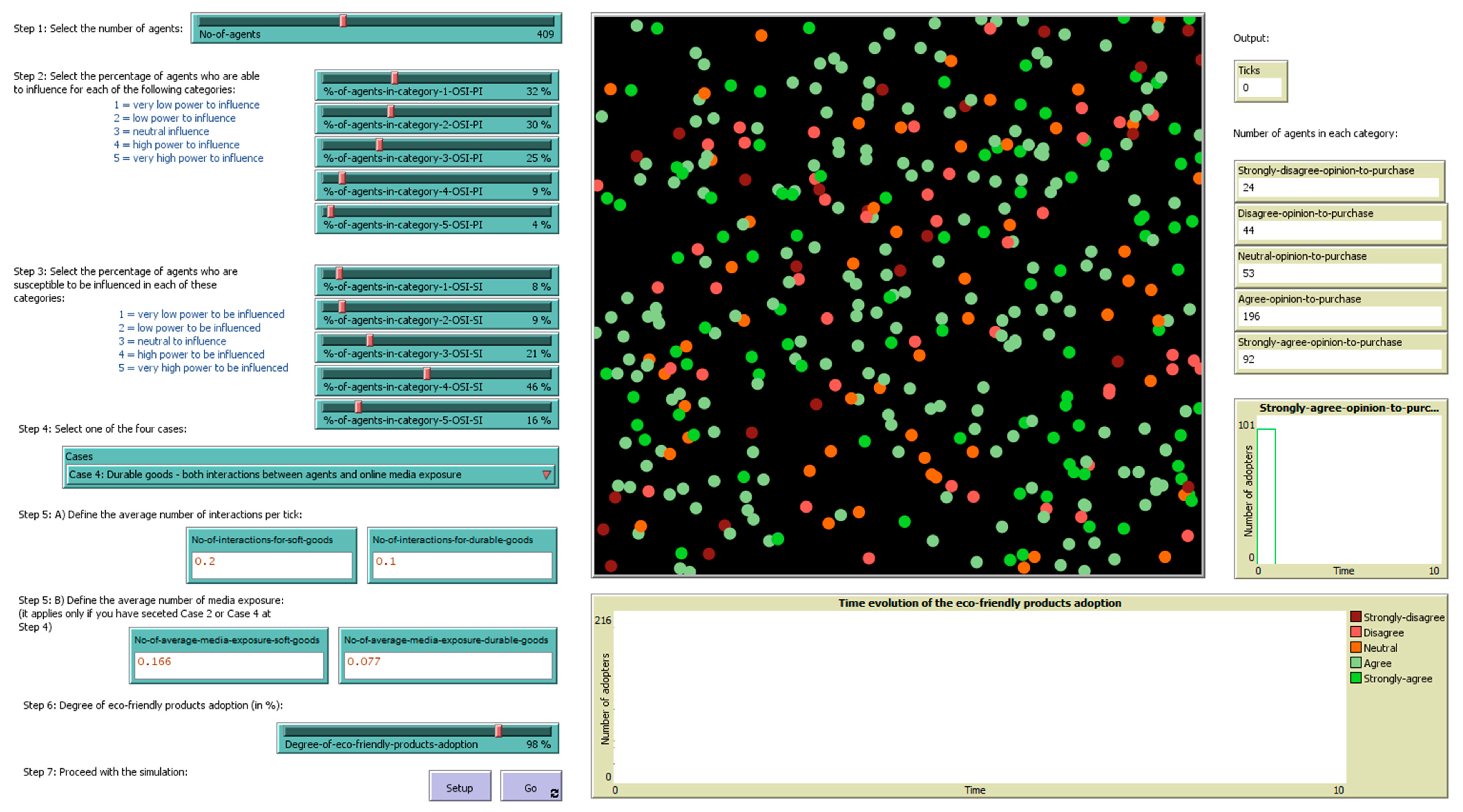
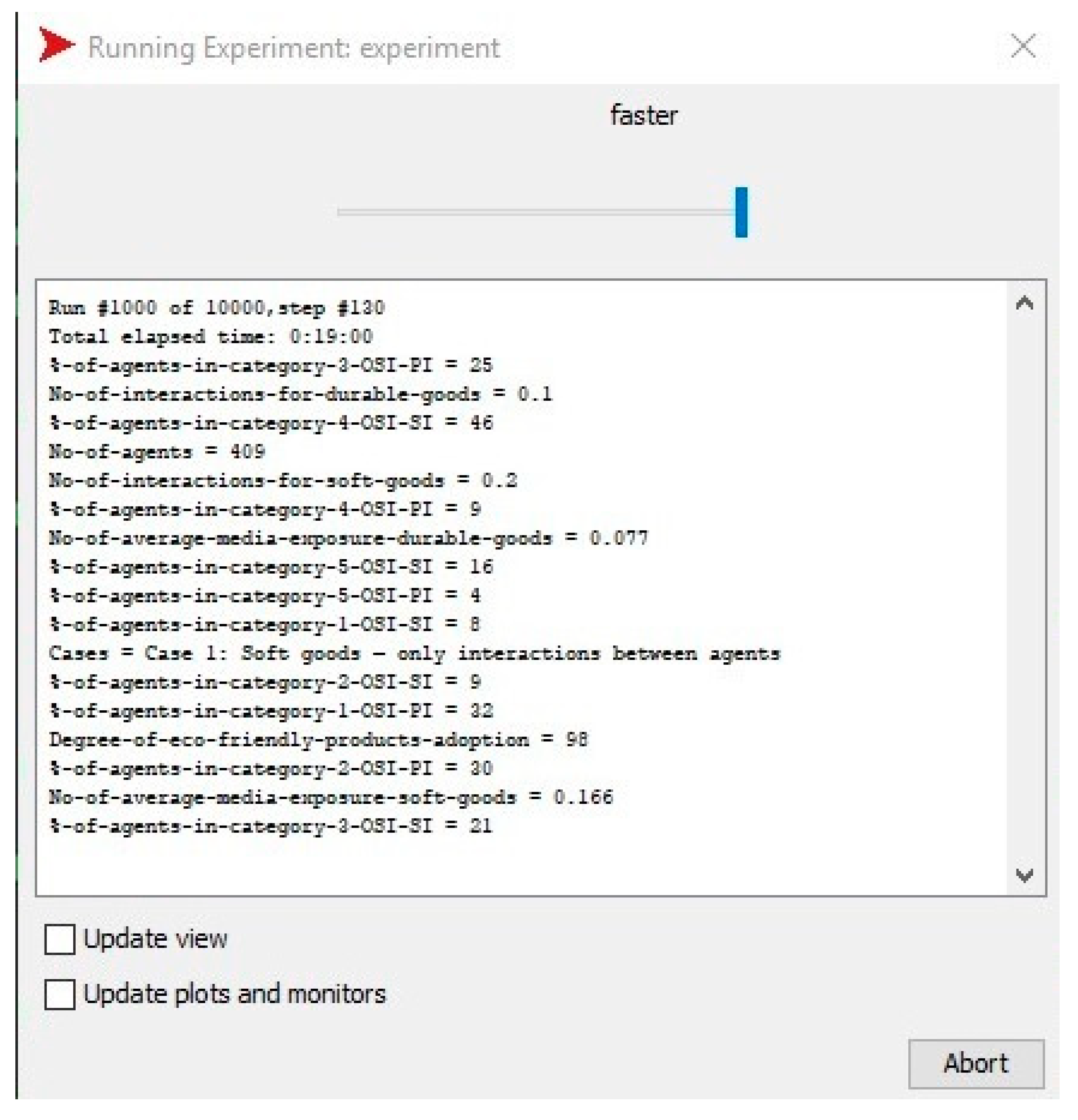
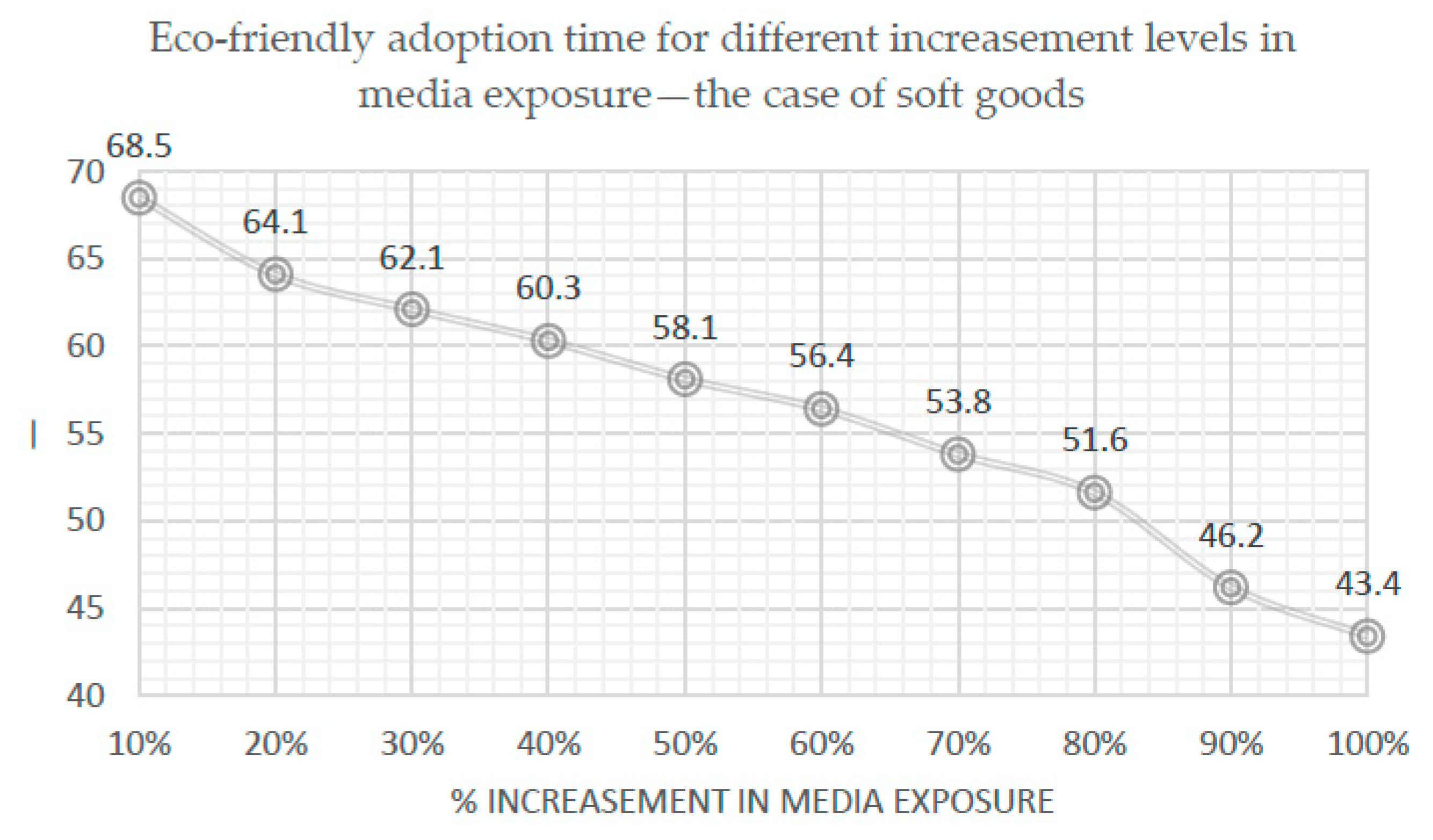
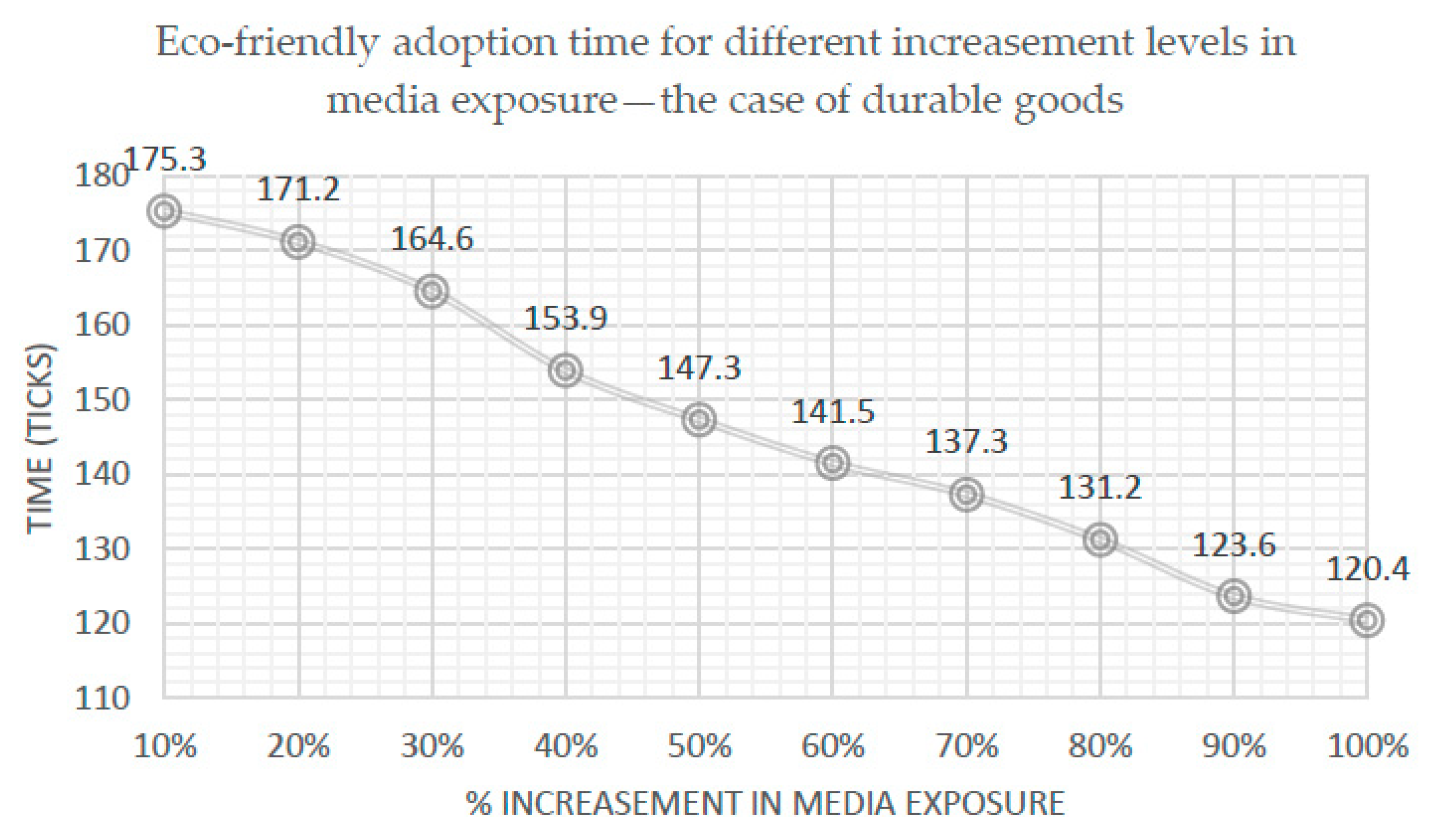
| E-AW | E-AT | OME | OSI-SI | OSI-PI | BID | KD | |
|---|---|---|---|---|---|---|---|
| E-AW1 | 0.661 | ||||||
| E-AW2 | 0.767 | ||||||
| E-AW3 | 0.848 | ||||||
| E-AT1 | 0.669 | ||||||
| E-AT2 | 0.926 | ||||||
| E-AT3 | 0.823 | ||||||
| OME1 | 0.872 | ||||||
| OME2 | 0.896 | ||||||
| OSI-SI1 | 0.813 | ||||||
| OSI-SI2 | 0.855 | ||||||
| OSI-SI3 | 0.895 | ||||||
| OSI-PI1 | 0.893 | ||||||
| OSI-PI2 | 0.896 | ||||||
| OSI-PI3 | 0.925 | ||||||
| BID1 | 0.732 | ||||||
| BID2 | 0.888 | ||||||
| BID3 | 0.780 | ||||||
| BID4 | 0.506 | ||||||
| BID5 | 0.676 | ||||||
| KD1 | 0.695 | ||||||
| KD2 | 0.781 | ||||||
| KD3 | 0.772 | ||||||
| KD4 | 0.735 | ||||||
| AVE | 0.581 | 0.661 | 0.782 | 0.731 | 0.819 | 0.529 | 0.557 |
| CR | 0.877 | 0.909 | 0.931 | 0.938 | 0.963 | 0.900 | 0.897 |
| Model | NPAR | CMIN | DF | P | CMIN/DF |
|---|---|---|---|---|---|
| Default model | 90 | 464.080 | 209 | 0.000 | 2.220 |
| Saturated model | 299 | 0.000 | 0 | ||
| Independence model | 23 | 5455.090 | 276 | 0.000 | 19.765 |
| Model | NFI Delta1 | RFI rho1 | IFI Delta2 | TLI rho2 | CFI |
|---|---|---|---|---|---|
| Default model | 0.915 | 0.888 | 0.951 | 0.935 | 0.951 |
| Saturated model | 1.000 | 1.000 | 1.000 | ||
| Independence model | 0.000 | 0.000 | 0.000 | 0.000 | 0.000 |
| Model | RMSEA | LO 90 | HI 90 | PCLOSE |
|---|---|---|---|---|
| Default model | 0.055 | 0.048 | 0.061 | 0.122 |
| Independence model | 0.214 | 0.210 | 0.219 | 0.000 |
| Case | No. of Ticks | ||
|---|---|---|---|
| Min | Max | Average | |
| Case1 | 280 | 699 | 484.19 |
| Case2 | 53 | 83 | 73.32 |
| Case3 | 572 | 1257 | 963.41 |
| Case4 | 147 | 245 | 191.73 |
| Case 2 | Population (No. of Agents) | |||||
|---|---|---|---|---|---|---|
| 100 | 200 | 400 | 600 | 800 | 1000 | |
| No. of ticks | 73.34 | 73.31 | 73.32 | 73.29 | 73.30 | 73.28 |
| Case 2 | % of Increasement in Social Media Exposure | |||||||||
|---|---|---|---|---|---|---|---|---|---|---|
| 10% | 20% | 30% | 40% | 50% | 60% | 70% | 80% | 90% | 100% | |
| No. of ticks | 68.5 | 64.1 | 62.1 | 60.3 | 58.1 | 56.4 | 53.8 | 51.6 | 46.2 | 43.4 |
| Time reduction (in ticks) | 4.8 | 9.2 | 11.2 | 13 | 15.2 | 16.9 | 19.5 | 21.7 | 27.1 | 29.9 |
| Time reduction (in %) | 6.6 | 12.6 | 15.3 | 17.8 | 20.8 | 23.1 | 26.6 | 29.6 | 37 | 40.8 |
| Case 4 | % of Increasement in Social Media Exposure | |||||||||
|---|---|---|---|---|---|---|---|---|---|---|
| 10% | 20% | 30% | 40% | 50% | 60% | 70% | 80% | 90% | 100% | |
| No. of ticks | 175.3 | 171.2 | 164.6 | 153.9 | 147.3 | 141.5 | 137.3 | 131.2 | 123.6 | 120.4 |
| Time reduction (in ticks) | 16.43 | 20.53 | 27.13 | 37.83 | 44.43 | 50.23 | 54.43 | 60.53 | 68.13 | 71.33 |
| Time reduction (in %) | 8.57 | 10.71 | 14.15 | 19.73 | 23.17 | 26.20 | 28.39 | 31.57 | 35.53 | 37.20 |
© 2019 by the authors. Licensee MDPI, Basel, Switzerland. This article is an open access article distributed under the terms and conditions of the Creative Commons Attribution (CC BY) license (http://creativecommons.org/licenses/by/4.0/).
Share and Cite
Delcea, C.; Cotfas, L.-A.; Trică, C.L.; Crăciun, L.; Molanescu, A.G. Modeling the Consumers Opinion Influence in Online Social Media in the Case of Eco-friendly Products. Sustainability 2019, 11, 1796. https://doi.org/10.3390/su11061796
Delcea C, Cotfas L-A, Trică CL, Crăciun L, Molanescu AG. Modeling the Consumers Opinion Influence in Online Social Media in the Case of Eco-friendly Products. Sustainability. 2019; 11(6):1796. https://doi.org/10.3390/su11061796
Chicago/Turabian StyleDelcea, Camelia, Liviu-Adrian Cotfas, Carmen Lenuța Trică, Liliana Crăciun, and Anca Gabriela Molanescu. 2019. "Modeling the Consumers Opinion Influence in Online Social Media in the Case of Eco-friendly Products" Sustainability 11, no. 6: 1796. https://doi.org/10.3390/su11061796
APA StyleDelcea, C., Cotfas, L.-A., Trică, C. L., Crăciun, L., & Molanescu, A. G. (2019). Modeling the Consumers Opinion Influence in Online Social Media in the Case of Eco-friendly Products. Sustainability, 11(6), 1796. https://doi.org/10.3390/su11061796







